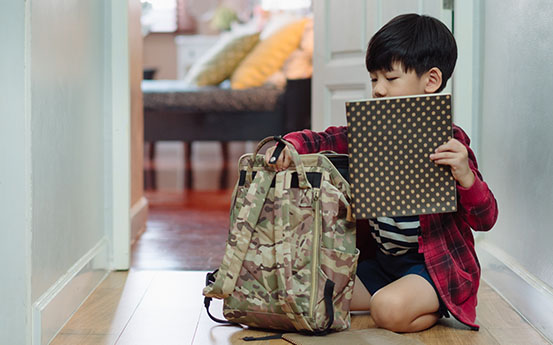Teaching children life skills is not only important for self-care, independence, and sufficiency— it also allows them to feel empowered, works on socialization and reasoning, and helps develop healthy self-esteem. According to Macmillan Education, “In a constantly changing environment, having life skills is an essential part of being able to meet the challenges of everyday life.”
Life skills are essentially any skills necessary (or useful) to manage our individual daily lives. Life skills include mental abilities such as resilience, problem-solving, and decision-making skills, to practical skills we use every day (brushing teeth, washing hands, cleaning up, and so on.). So, without further ado, the following are 20 life skills you can teach your child, no matter their age!
- Teach (or, remind) your child how to wash her hands (for 20-whole seconds!). Encourage her to sing as she scrubs!
- Encourage your child to sort his toys (sorting is the natural first step to teaching him how to put away his toys!).
- Invite your child to pick out her own clothes and to dress herself (the less the clothes match, the better!!).
- Invite your child to help you water plants; ask for help filling watering cans (or cups) with water, and teach him how to safely water plants, flowers, and seeds.
- Lighten your own laundry load by teaching your child how to match and fold socks!
- Help your child learn how to snap, zip, and button!
- Show your child how to wash her own face and invite her to continue doing so on her own!
- Take some time to teach your child your phone number and address.
- Talk with your child about what an ‘emergency’ is and then show them how to dial 9-1-1 (continue the discussion about the sort of emergency that necessitates 9-1-1!).
- Invite your child to set the table before breakfast, lunch and/or dinner (start small such as asking him to place one napkin for each diner, and so on).
- Continue laundry lessons by teaching your child how to sort her dirty clothes by color!
- Teach your child how to make a simple sandwich (spreading peanut butter can be a bit tricky, but lunchmeat, cheese, or other sun-butters are easy to manipulate and build with!).
- Once the laundry is folded, encourage your child to put his clothes away (in the right places!).
- Invite your child to make her bed! Pull up the sheets, spread out the blanket, place the pillows in just the right spot, and fold blankets that ‘live’ at the end of the bed! And, just in case your child forgets, remind her to tuck their stuffed animals in!
- Cleaning windows is not a task most adults enjoy, but you may be surprised at your child’s delight when it comes to spraying and wiping a window! Show your child how you clean height-appropriate windows and invite him to follow your lead!
- A full-sized broom and dustpan can be tough for little hands to maneuver, but small broom/dustpan sets can be found in many a dollar bin and they are perfectly sized for young children. If (or, when) you find yourself sweeping up a mess, encourage your child to follow-suit with her mini-sized brush and dustpan.
- Small kitchen tasks are perfect for the short attention spans of young children and are a great way to spend more time with your child as he learns important cooking to-dos! Invite your child to assist you in stirring batter in a bowl (if you rather not risk a batter mess, start by having your child practice stirring with water and dish-soap, practicing to keep the water in the bowl!), rinsing and straining fresh fruit and vegetables, pouring liquid ingredients, using cookie or biscuit cutters, or measuring dry or liquid ingredients
- Teach your child when, how, and how much food and water your pets need (and then turn the chore over to her!).
- These tasks may seem odd, but they serve a dual purpose in that they provide excellent fine-motor practice (which is a great way to ensure children are confident about holding writing utensils!), and they are just plain-practical! Hole-punching (provide your child with a single (or three-hole) hole-punch and challenge him to see how many holes he can punch in a sheet of paper (by the way, when he is done doing so he can grab his kid-sized broom and dustpan!). Attach paper clips (invite your child to attach paper clips to multiple pieces of paper; encourage him to determine how many pieces of paper is too many, how many is just the right amount, and so on!). Attach clothespins (whether to a clothing line, cardboard, or opened chip or cereal bags!).
- Last, but not least, cutting with scissors is a tough task to master, but providing your child multiple opportunities to practice cutting is a sure-fire way to ensure they are master cutters! Start with rounded scissors and playdough or clay, and as she grows more confident holding and maneuvering the clay and the scissors, move onto rounded scissors and paper.
The main thing to remember with teaching life skills is to have things accessible for your child to use. Consider having as many things as you can within eye-level of your child. It may mean rearranging some things in your home, but it will help to encourage independence in your child's day to day life!
Although many adults think of chores (a.k.a. practical life skills) as tedious, your young child will very likely enjoy tackling these skills and now, while they are young, is the perfect time to harness that excitement while teaching them useful, life-long skills!

